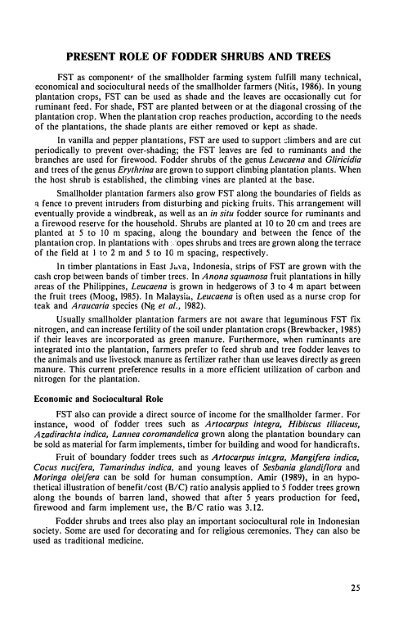Proceedings of a workshop on research methodologies Medan ...
Proceedings of a workshop on research methodologies Medan ...
Proceedings of a workshop on research methodologies Medan ...
You also want an ePaper? Increase the reach of your titles
YUMPU automatically turns print PDFs into web optimized ePapers that Google loves.
PRESENT ROLE OF FODDER SHRUBS AND TREES<br />
FST as comp<strong>on</strong>entf <str<strong>on</strong>g>of</str<strong>on</strong>g> the smallholder farming system fulfill many technical,<br />
ec<strong>on</strong>omical and sociocultural needs <str<strong>on</strong>g>of</str<strong>on</strong>g> the smallholder farmers (Nitis, 1986). In young<br />
plantati<strong>on</strong> crops, FST can be used as shade and the leaves are occasi<strong>on</strong>ally cut for<br />
ruminant feed. For shade, FST are planted between or at the diag<strong>on</strong>al crossing <str<strong>on</strong>g>of</str<strong>on</strong>g> the<br />
plantati<strong>on</strong> crop. When the plantati<strong>on</strong> crop reaches producti<strong>on</strong>, according to the needs<br />
<str<strong>on</strong>g>of</str<strong>on</strong>g> the plantati<strong>on</strong>s, the shade plants are either removed or kept as shade.<br />
In vanilla and pepper plantati<strong>on</strong>s, FST are used to support Jimbers and are cut<br />
periodically to prevent over-shading; the FST leaves are fed to ruminants and the<br />
branches are used for firewood. Fodder shrubs <str<strong>on</strong>g>of</str<strong>on</strong>g> the genus Leucaena and Gliricidia<br />
and trees <str<strong>on</strong>g>of</str<strong>on</strong>g> the genus Erythrina are grown to support climbing plantati<strong>on</strong> plants. When<br />
the host shrub is established, the climbing vines are planted at the base.<br />
Smallholder plantati<strong>on</strong> farmers also grow FST al<strong>on</strong>g the boundaries <str<strong>on</strong>g>of</str<strong>on</strong>g> fields as<br />
a fence to prevent intruders from disturbing and picking fruits. This arrangement will<br />
eventually provide a windbreak, as well as an in situ fodder source for ruminants and<br />
a firewood reserve for the household. Shrubs are planted at 10 to 20 cm and trees are<br />
planted at 5 to 10 m spacing, al<strong>on</strong>g the boundary and between the fence <str<strong>on</strong>g>of</str<strong>on</strong>g> the<br />
plantati<strong>on</strong> crop. In plantati<strong>on</strong>s with : 'opes shrubs and trees are grown al<strong>on</strong>g the terrace<br />
<str<strong>on</strong>g>of</str<strong>on</strong>g> the field at I to 2 m and 5 to 10 m spacing, respectively.<br />
In timber plantati<strong>on</strong>s in East Jva, Ind<strong>on</strong>esia, strips <str<strong>on</strong>g>of</str<strong>on</strong>g> FST are grown with the<br />
cash crop between bands <str<strong>on</strong>g>of</str<strong>on</strong>g> timber trees. In An<strong>on</strong>a squamnosa fruit plantati<strong>on</strong>s in hilly<br />
areas <str<strong>on</strong>g>of</str<strong>on</strong>g> the Philippines, Leucaena is grown in hedgerows <str<strong>on</strong>g>of</str<strong>on</strong>g> 3 to 4 m apart between<br />
the fruit trees (Moog, 1985). In Malaysia, Leucaena is <str<strong>on</strong>g>of</str<strong>on</strong>g>ten used as a nurse crop for<br />
teak and Araucaria species (Ng et al., 1982).<br />
Usually smallholder plantati<strong>on</strong> farmers are not aware that leguminous FST fix<br />
nitrogen, and can increase fertility <str<strong>on</strong>g>of</str<strong>on</strong>g> the soil under plantati<strong>on</strong> crops (Brewbacker, 1985)<br />
if their leaves are incorporated as green manure. Furthermore, when ruminants are<br />
integrated into the plantati<strong>on</strong>, farmers prefer to feed shrub and tree fodder leaves to<br />
the animals and use livestock manure as fertilizer rather than use leaves directly as green<br />
manure. This current preference results in a more efficient utilizati<strong>on</strong> <str<strong>on</strong>g>of</str<strong>on</strong>g> carb<strong>on</strong> and<br />
nitrogen for the plantati<strong>on</strong>.<br />
Ec<strong>on</strong>omic and Sociocultural Role<br />
FST also can provide a direct source <str<strong>on</strong>g>of</str<strong>on</strong>g> income for the smallholder farmer. For<br />
instance, wood <str<strong>on</strong>g>of</str<strong>on</strong>g> fodder trees such as Artocarpus integra, Hibiscus tiliaceus,<br />
Azadirachtaindica, Lannea coromandelicagrown al<strong>on</strong>g the plantati<strong>on</strong> boundary can<br />
be sold as material for farm implements, timber for building and wood for handicrafts.<br />
Fruit <str<strong>on</strong>g>of</str<strong>on</strong>g> boundary fodder trees such as Artocarpus intcgra, Mangifera indica,<br />
Cocus nucifera, Tainarindusindica, and young leaves <str<strong>on</strong>g>of</str<strong>on</strong>g> Sesbania glandiflora and<br />
Moringa oleifera can be sold for human c<strong>on</strong>sumpti<strong>on</strong>. Amir (1989), in an hypothetical<br />
illustrati<strong>on</strong> <str<strong>on</strong>g>of</str<strong>on</strong>g> benefit/cost (B/C) ratio analysis applied to 5 fodder trees grown<br />
al<strong>on</strong>g the bounds <str<strong>on</strong>g>of</str<strong>on</strong>g> barren land, showed that after 5 years producti<strong>on</strong> for feed,<br />
firewood and farm implement -use, the B/C ratio was 3.12.<br />
Fodder shrubs and trees also play an important sociocultural role in Ind<strong>on</strong>esian<br />
society. Some are used for decorating and for religious cerem<strong>on</strong>ies. They can also be<br />
used as traditi<strong>on</strong>al medicine.<br />
25

















